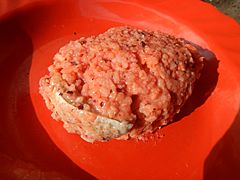Burong isda facts for kids
 |
|
| Course | Main dish |
|---|---|
| Place of origin | Philippines |
| Region or state | Central Luzon |
| Variations | burong dalag (snakehead); burong bangus (milkfish); burong hito (catfish); burong gurami (gourami), etc. |
| Similar dishes | Tinapayan, Balao-balao, Narezushi, Pla ra |
Burong isda is a traditional Filipino dish. It means "fermented fish" in English. This unique food is made by mixing cooked rice with raw, cleaned fish. Salt and sometimes a special red yeast rice called angkak are added. The mixture is then left to ferment for about a week. This process helps to preserve the fish and gives it a special tangy flavor.
You'll find burong isda commonly eaten in the Central Luzon region of the Philippines, especially in the province of Pampanga. Sometimes, the angkak (red yeast rice) is not used, which results in a white-colored version of the dish.
Contents
What is Burong Isda?
Burong isda is a type of fermented food. It's a way people have preserved food for a long time, especially before refrigerators were common. The word "burong" means "pickled" or "fermented."
How is Burong Isda Made?
To make burong isda, fresh fish is first cleaned and filleted (meaning the bones are removed). Then, it's mixed with cooked rice and salt. In some areas, a special ingredient called angkak is added. Angkak is a type of red yeast rice that helps with the fermentation process and gives the dish a reddish color. The mixture is then placed in a container and left to ferment for about a week. During this time, natural bacteria help to break down the fish and rice, creating new flavors and preserving the food.
Different Kinds of Burong Isda
The name of burong isda often changes based on the type of fish used. For example, if it's made with bangus (milkfish), it's called burong bangus. Other popular fish used include dalag (snakehead), hito (catfish), and gurami (gourami). There are also versions made with shrimp, which are known as burong hipon or balao-balao.
Why Ferment Food?
Fermentation is an old method of preserving food. It uses helpful microorganisms, like bacteria and yeast, to change the food. These microorganisms produce acids, like lactic acid, which prevent harmful bacteria from growing. This process not only keeps food from spoiling but also often adds unique flavors and can even make nutrients easier for our bodies to absorb.
Burong Isda Around Asia
Burong isda is not the only fermented fish and rice dish in Asia. Many cultures have similar foods. For example, narezushi from Japanese cuisine is an ancient form of sushi that also involves fermenting fish with rice. Another similar dish is Pla ra from Thai cuisine, which is a fermented fish sauce or paste. All these dishes use the power of fermentation to preserve food and create distinct tastes.

